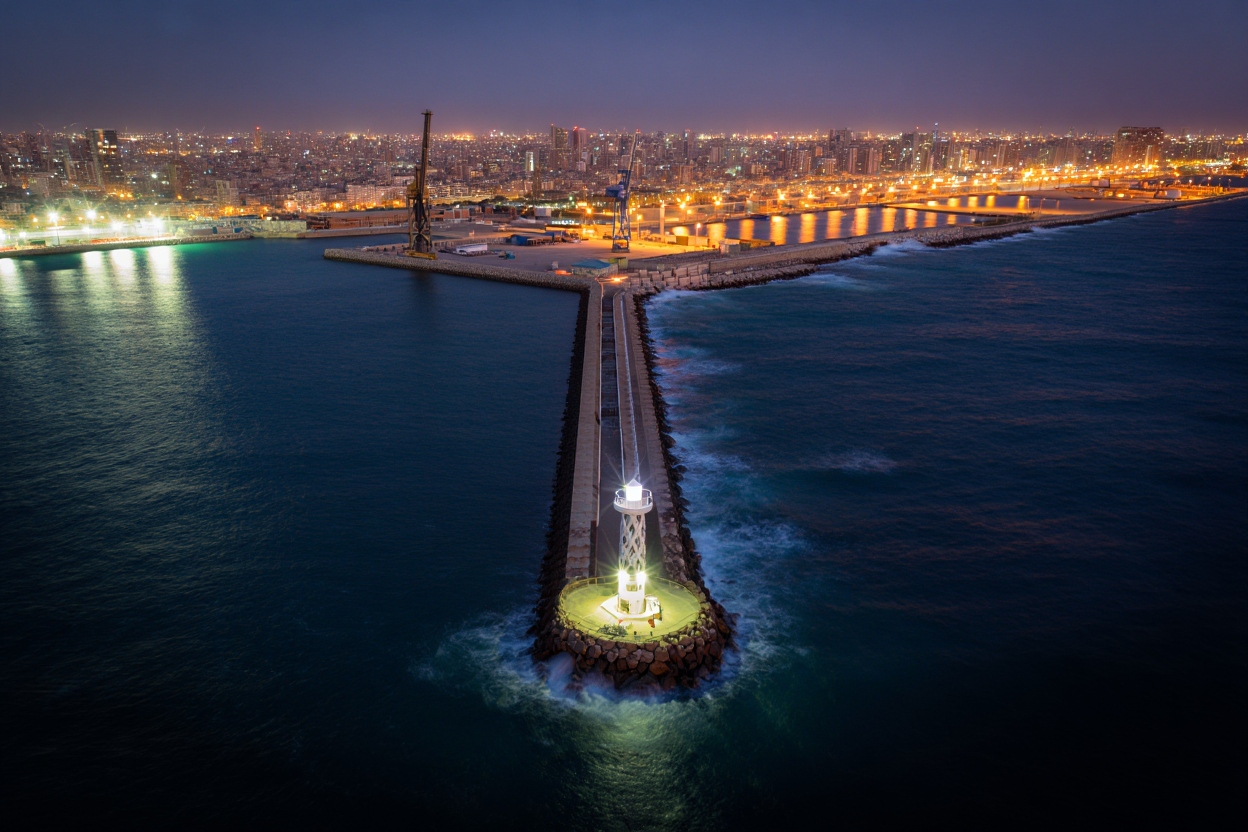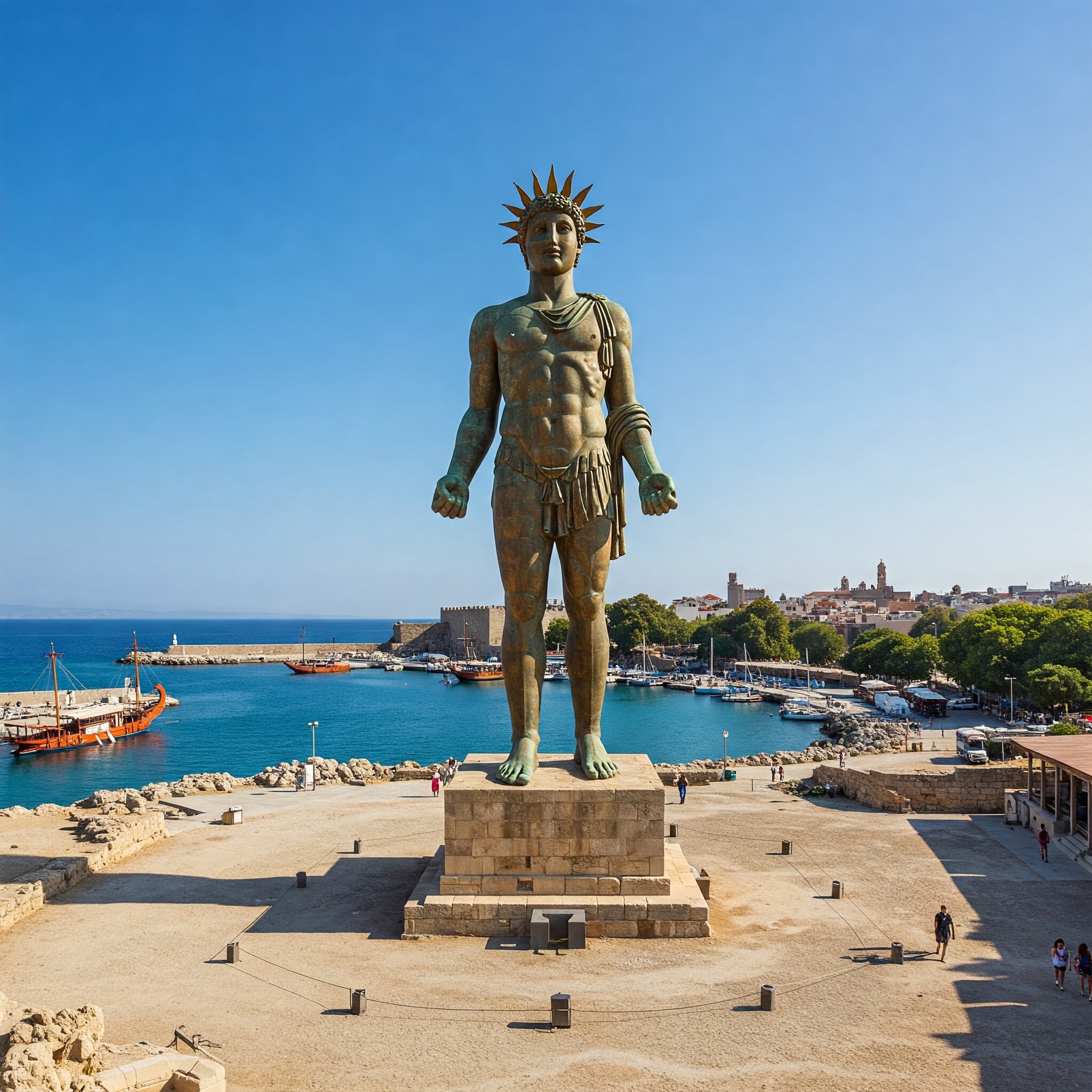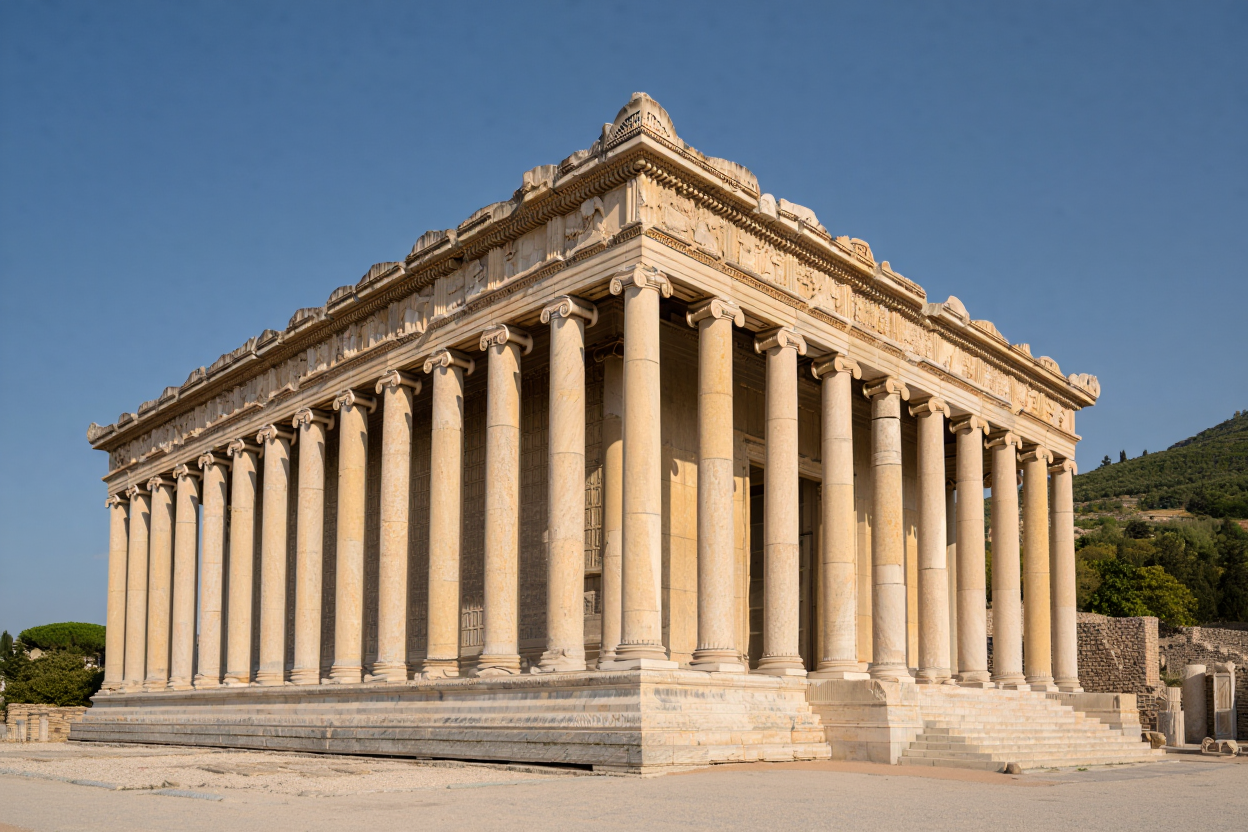Are you ready to step into a world where the Colossus of Rhodes still towers over the Aegean and casts its shadow over bustling harbors, or where the Hanging Gardens of Babylon bloom in the heart of the metropolis?
The Seven Wonders of the Ancient World were more than architectural feats, becoming bold statements of human ambition, power, and artistry. With time, wars and nature having their way, today, they only exist in fragments, old records, or myths.
What if they hadn’t disappeared? What if they had survived over the centuries and adapted to modern landscapes, standing among today’s skyscrapers? With a bit of help from history, archaeology, and a little creative imagination, we’ll reimagine what these lost wonders would look like standing today.

The Lighthouse of Alexandria
Just off the coast of Alexandria, standing on the small island of Pharos, the Lighthouse of Alexandria was one of the tallest man-made structures created in the ancient world. It reached an estimated height of 330-426 feet. It was built in the 3rd century BCE, during the reign of Ptolemy II. Its purpose was to guide sailors safely into the city’s bustling harbor.
Historical records describe it as having a three-tiered structure: a square base, a cylindrical midsection, and a smaller, circular tower at the top, which was crowned by a statue, possibly Poseidon or Zeus.
In some reports, there are claims of fire reflected by polished bronze mirrors that could be seen from 31 miles away.
Why it disappeared
The lighthouse withstood the elements for centuries, but the earthquakes managed to slowly chip away at its foundation. Between the 10th and 14th centuries, there was a series of powerful earthquakes that caused severe damage. By 1480, what remained of the Lighthouse was repurposed to build the Citadel of Quaitbay, a fortress that still stands. By then, the lighthouse was nothing more than a legend, a memory of a civilization that once commanded the Mediterranean.
How it might look today
If the lighthouse had survived until today, it would be one of the most famous landmarks, standing as a proud symbol of Egypt’s maritime history.
With several restorations, such as the Colosseum or the Great Wall of China, and modern lighting systems that would replace the fire, it would serve both as a historical monument and a functional lighthouse.
Considering Alexandria’s development, this is an area that could’ve turned into a vibrant waterfront district, filled with cafes, museums, and observation decks offering breathtaking views of the sea.
The Hanging Gardens of Babylon
They are the most mysterious of the Seven Wonders, and we are not even sure they existed. Ancient Roman and Greek writers, including Philo of Byzantium and Strabo, described a massive, multi-tiered garden that was filled with lush greenery, exotic flowers, and cascading waterfalls. These gardens were supposedly built by King Nebuchadnezzar II in the 6th century BCE.
According to the sayings, the gardens were a gift to his wife, Amytis of Media, longing for the mountainous landscape of her homeland. An engineering marvel, the structure used an advanced irrigation system to lift water from the Euphrates River and nourish the plants.
Why it disappeared
If they were real, they likely disappeared due to natural disasters and neglect. This region was prone to earthquakes, and it needed constant upkeep to maintain an artificial oasis in the scorching Mesopotamian climate.
By the time Alexander the Great conquered Babylon in 331 BCE, the city was already in decline, and over the centuries, the ruins got swallowed by time, war, and shifting civilizations. The gardens may have crumbled away if they had existed.
How it might look today
They would for sure be one of the greatest tourist attractions in the world, possibly rivaling the Taj Mahal or the Palace of Versailles. Would you not be in awe of a multi-tiered botanical wonder in the middle of modern Baghdad, with vegetation, terraced balconies, and artificial waterfalls? They would serve both as a historical site and a breathtaking green space in an arid landscape.
The Hanging Gardens could be the model for modern eco-cities, an early example of integrating nature into urban environments.

The Colossus of Rhodes
An enormous bronze statue of the sun god Helios, over 108 feet tall, made it one of the tallest statues of the ancient world. It was built around 280 BCE to celebrate Rhodes’ victory over an invading army. The statue is believed to tower over the island’s main harbor, and there’s a debate about whether it straddles the entrance like a guardian. What we know for sure is that it was made from bronze and iron, gleaming in the sun, and it was designed to showcase Rhodes as an unstoppable naval force.
Compared to later statues such as the Statue of Liberty, it was given that the Colossus was built with materials from defeated enemy weapons, which makes it a literal and symbolic representation of victory. Standing proudly for decades, it impressed sailors and traders who arrived on the island.
Why it disappeared
It reportedly stood for about 54 years before the earthquake in 226 BCE made it crash down. The statue broke at the knees, and its remains lay scattered along the harbor for centuries. Even with the efforts to repair it, an oracle warned against rebuilding, so the citizens of Rhodes left it in ruins.
In its broken state, it’s still a wonder to behold, and visitors would marvel at the sheer size of the fallen pieces.
In the 7th century CE, conquerors allegedly sold the remaining bronze for scrap, so the Colossus was melted down and lost to history. There are rumors of fragments still being buried somewhere beneath Rhodes.
How it might look today
If it survived, it would certainly be one of the most iconic statues in the world, alongside the Christ statue in Brazil or the Statue of Liberty in New York.
Rhodes could’ve built a modern city around it, making it a focal point for culture and tourism.
The Statue of Zeus at Olympia
Another masterpiece of ancient sculpture, the Statue of Zeus, was created by the renowned artist Phidias around 435 BCE. 40 feet tall, it pictured the king of the gods on a magnificent throne, crafted from gold, ivory, and wood.
Zeus was wearing a robe made of gold and held a statue of Nike, the goddess of victory, in one hand and a scepter topped with an eagle in the other. According to some accounts, the statue was so huge that viewers could only see its head and feet from the door, making it own an overwhelming sense of presence.
Why it disappeared
The statue was eventually lost in time. The temple and everything inside were damaged by the earthquakes of the 5th century CE, and although the statue survived for some time, it was moved to Constantinople.
It’s believed to be destroyed by fire there, and some theories claim the statue has been melted down for its precious metals, and others suggest it simply decayed over time.
How it might look today
If the statue had survived, it would be the central monument of Western culture, rivaling modern-day landmarks such as the Lincoln Memorial or the Christ the Redeemer statue in Brazil. The statue could’ve been kept in a climate-controlled environment to allow visitors to experience it in all its glory.
It would stand as a symbol of human achievement and artistic innovation, showing the impressive skills of ancient sculptors.
The Mausoleum at Halicarnassus
A grand tomb was built for Mausolus, the Persian satrap of Caria, and his wife, Artemisia. It was completed around 350 BCE, and it stood in the city of Halicarnassus, modern-day Bodrum, Turkey. This architectural marvel reached around 148 feet in height, and it was adorned with stunning sculptures, friezes, and reliefs that celebrated the royal couple’s legacy and power.
Why it disappeared
The mausoleum was initially revered as one of the Seven Wonders, and its grandeur didn’t save it from the forces of nature and time. It was damaged multiple times over the centuries, considering the earthquakes in the Middle Ages, which caused the structure to slowly collapse.
By the time archaeologists began to explore the site, little more than ruins remained, and the beautiful sculptures that once adorned the mausoleum were scattered across museums in Europe.
How it may look today
If the Mausoleum survived, it would be a breathtaking fusion of architecture, ancient art, and history. Imagine the grand pyramid and chariot soaring over the landscape or being reinforced against time’s weight. A carefully preserved mausoleum could be the centerpiece of a vast archaeological park where visitors could wander through its lush garden, showing the remaining sculptures that once decorated the structure.
If it were rebuilt today, the Mausoleum could stand as a stunning tribute to the rulers who once commanded the region and offer a glimpse into a time when the boundary between life and death was marked with awe-inspiring artistry.

The Temple of Artemis at Ephesus
Located in the ancient city of Ephesus, it was one of the largest and most significant temples ever built. It was constructed around 550 BCE and dedicated to the Greek goddess Artemis, the goddess of hunting and fertility. This temple stood approximately 417 meters long and 226 feet wide, and it featured 127 grand columns (60 feet tall). It was one of the largest temples of the ancient world.
The temple was renowned for its intricate artwork and stunning sculptures. It housed a massive statue of Artemis, carved from gold, silver, and other materials.
The temple served as a place of worship and as a cultural and commercial hub for the region. The grandeur of its structure and the beauty of its detailed friezes and artwork.
Why it disappeared
The Temple of Artemis was destroyed by a flood around 600 BCE, and it was shortly rebuilt after. The second version of the temple suffers a far worse fate on the night of Alexander the Great’s birth (356 BCE).
The temple was set on fire by a man named Herostratus, who sought to achieve fame through the destruction of this monumental structure. Despite the rebuilding efforts, the temple was never restored to its former glory.
How it might look today
A modern-day temple would serve as a powerful connection to architecture and ancient Greek religion, but it would also be a place of reflection on human creativity and their resilience.
The Great Pyramid of Giza
What It Looked Like Back Then
Built for Pharaoh Khufu around 2600 BCE, the Great Pyramid of Giza stood at an astonishing 481 feet tall. It’s believed that limestone casing stones made the surface dazzlingly white, reflecting the sun’s rays so brightly that it must have looked like it was glowing. Ancient accounts describe its perfectly aligned sides as a monument of precision.
We know a lot about the Great Pyramid because it still exists, even though time has worn away the smooth casing stones, leaving the blocks exposed.
Why It Disappeared
Technically, it didn’t! The Great Pyramid is the only Wonder of the Ancient World still standing today. Its outer polished limestone was removed over centuries, during the Middle Ages, when the stones were repurposed for new building projects in Cairo. Erosion and earthquakes also damaged parts of the structure, giving it the rugged look of today.
How It Might Look Today
It would be absolutely jaw-dropping: a massive, gleaming beacon visible for miles across the desert. Imagine the sunlight hitting its polished surface, making the monument look like a shard of light against the sky.
The pyramid could have solar-powered lighting at night, in a modern setting, casting a soft, otherworldly glow. It would serve as an international symbol of human achievement and mystery.
Read next: 10 Photos of Celebrities Before They Were Famous


